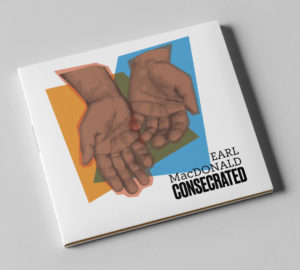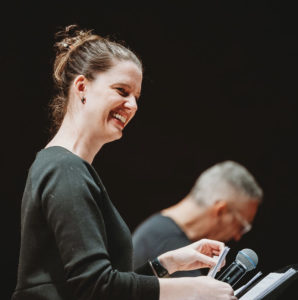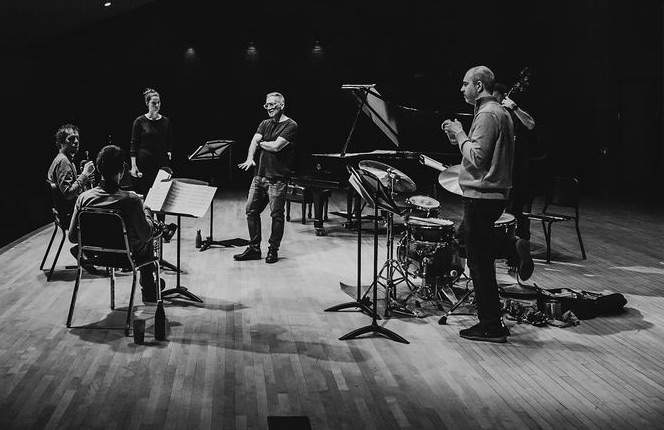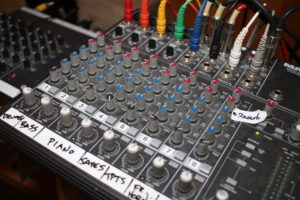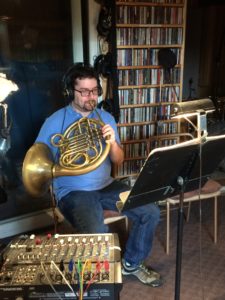Album production and all it entails requires a wide range of skillsets beyond making musical judgements in the studio. A music producer’s roles include organization, planning, creative problem solving, and the ability to address minutia and the big picture simultaneously. In this write-up, I will provide a glimpse into the production of my new album, “Consecrated.” As a precursor, you may wish to read my thoughts on selecting musicians for this project. (The topic warranted its own article, although hiring musicians often falls under the umbrella of a music producer’s responsibilities.)
In brief, this project features two musicians who reside in Winnipeg, Canada (Karl Kohut and Karly Epp), while the remainder of the band is based in New York and Connecticut. Album production takes on added layers of complexity when portions of the band live in separate countries. Basic questions quickly arose, like:
“Where will we record?”
“When and where will we rehearse?”
“How will all of this be feasible?”
Selecting Dates & the Studio Location
Glancing ahead in my calendar, I saw upcoming festival adjudication commitments in Grand Forks, North Dakota (January, 2020) and Brandon, Manitoba (March, 2020). Some quick research showed that flying to Winnipeg and then driving to Grand Forks was considerably cheaper than flying round trip to Grand Forks. The festival sponsors loved this, plus it gave me the opportunity to rehearse with Karl and Karly without paying for flights!
Although I considered recording in Winnipeg in March, I ultimately chose to record at PBS Studios in Westwood, Massachusetts, during Karl and Karly’s February spring break. In hindsight, if I hadn’t abandoned the plan to record in Canada, the recording never would have happened due to the imminent pandemic none of us foresaw.
A few factors informed my decision to record at PBS (Peter’s Basement Studio). I have recorded and mixed several projects there, so I know what to expect. Engineer, Peter Kontrimas always gets a great sound and I like his Yamaha piano. The studio is only about an hour from my house, and I would have plenty of great East Coast musicians from which to choose. When I learned that Karl and Karly could get travel research funds from the University of Manitoba to cover their expenses, the choice was obvious.
I booked the studio, hired the remaining musicians, and got everything scheduled by making some calls.
Grant Applications
The financial aspects of budgeting, grant writing and/or identifying other sources of funding is another integral aspect of any managing any recording project. I won’t go into great detail here, other than to mention that I keep an annual calendar with researched grant application deadlines on it. I’m often thinking ahead to what my next project might be and what grants might be available to bring a project to fruition. When I decided to pursue this project, the timing fortunately coincided with several advertised deadlines, and my proposals were successful.
Choosing Songs and Keys
I have written far more hymn arrangements than one album could contain. So, I sent lists of titles to Karly, asking her to eliminate pieces to which she had no personal connection. I then followed-up with demos I recorded with my iPhone, to suggest each arrangement’s general feel. Going back-and-forth over e-mail, we narrowed the list to ten favorites which stylistically and lyrically complemented one another. I then had Karly and Karl select keys for each piece, to best suit Karly’s vocal range and timbre. Because she is an alto, most keys required lowering. Once keys were set, I got to work tweaking arrangements.
Rehearsing In-Person
In January, after my gig in North Dakota, I drove a rental car up to Winnipeg. I rehearsed with Karl and Karly at the University of Manitoba, after they completed their teaching duties. We “ironed out” many important details. But most importantly, it was clear that musical chemistry existed between the three of us. I could sense the music was going to be special.
Additionally, the following day we had a second “open rehearsal” within their music department’s student convocation. All their university jazz students attended. We performed the pieces and I briefly discussed my arranging approaches for each selection. Providing the students with a glimpse into this future recording, and answering their questions made for a fun afternoon.
Distributing Music to the Band
In the weeks between rehearsing and the scheduled recording date, I fine-tuned the arrangements, and uploaded everything on a private web page to which only the band had access. I included recorded demos, again made with my iPhone during the rehearsal with Karl and Karly. Everyone had the music and my performance instructions several weeks before the session. This ensured everyone’s familiarity with the music, so there would be no surprises.
“Game Day” Preparations
Perhaps the most important aspect of album production is planning every detail of the recording day(s). Here’s the schedule I planned:
Wednesday, Feb. 19, 2020
10:00AM – noon: rehearsal in UConn’s von der Medhen Recital Hall, Storrs, CT
12:00 – 1:00PM: lunch and video interviews
1:00 PM: drive from Storrs, CT to PBS Studios in Westwood, MA
2:00 – 3:30 PM: set up and souund check
4:00- 7:00PM: tracking
7:00 – 8:30PM: dinner @ local restaurant
9 – 11:30PM: tracking
11:30PM: check into local hotel
Thursday, Feb. 21, 2020
9:00 AM: return to studio
9:30AM – 1PM: tracking
1:00 – 1:45PM: lunch (sandwiches delivered)
2:00 – 5:00 PM: tracking
To clarify, the schedule only represents the tip of the iceberg in planning a recording session. Countless details made it onto my “To Do” lists leading up to the recording. These included: booking a the rehearsal hall, arranging for parking passes, coordinating airport pick-ups, borrowing string basses for the rehearsal and session, considering dietary restrictions, planning meals, hiring a photographer and videographer to document the rehearsal, booking hotel rooms, providing directions, etc. Album production is about a whole lot more than music making!
Because of the amount of pre-planning I did, I was able to focus mostly on music during the day of the recording. I delegated jobs to others whenever possible, and followed my plan like a script. Although there are always unanticipated difficulties, no derailing incidents occurred.
PBS Recording Studio Floor Plan
Here’s the floor plan of Peter’s Basement Studio:
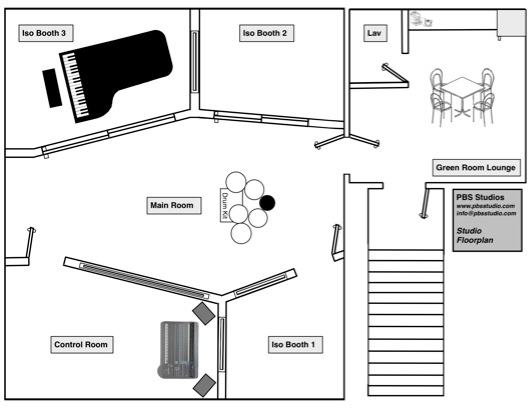 For this session, the drums were situated in Iso Booth 2, and the horns were in the main room. Karly sang her vocals in the Control Room; and Karl played the string bass in Iso Booth 1. Each of us got our own, adjustable headphone mix, using a little mixing board such as this:
For this session, the drums were situated in Iso Booth 2, and the horns were in the main room. Karly sang her vocals in the Control Room; and Karl played the string bass in Iso Booth 1. Each of us got our own, adjustable headphone mix, using a little mixing board such as this:
In most instances, we recorded each song about three times. I used a metronome during “count-offs” to ensure tempos would be similar. This makes editing easier in post-production, should some musical element need to be “borrowed” from another take. Often, during the third take, I encouraged Karly to take some risks with her vocal interpretations. Special musical moments often resulted.
Overdubbing Instruments
With the exception of “By Our Love,” everything was recorded conventionally. “By Our Love” required the overdubbing of horns, as the song is orchestrated for an 11-piece ensemble consisting of 2 trumpets, French horn, trombone, alto, tenor & bari sax, vocals, piano, bass and drums. Kris Allen overdubbed all three saxophone parts. But first, I had him record a “dummy track” with the rhythm section, which incorporated all of the chart’s lead lines. As he and trumpeter Dave Smith recorded their parts, they listened to this “dummy track” through their headphones, aligning their parts with it. Later, we discarded this track.
For the beginning and the chorale ending, I conducted the horns from an isolation both, while counting into a microphone, to guide the horns which would be layering their parts against the out-of-time drums.
We added trombone, French horn and the piano solo another day. The required length of the piano solo section needed to correspond to an animated video which was still in production. We looped the underpinning ostinato bass line a few extra times to maximize flexibility.
Selecting Master Tracks
I left the studio with rough CD mixes of every recorded take. I waited about a week before listening to anything, and then did so with a notebook in hand. Because everyone in the band is an accomplished improviser, there were considerable differences from take to take. I had many creative options and choices to make. Once favorite takes were selected, I identified any glitches which could be corrected using material in the other takes. Additionally, I made note of stellar moments in alternate takes, for possible incorporation (through editing) into the master tracks.
Album Post-Production
By the time I was ready to head back to Peter’s studio to assemble everything and start mixing, the pandemic hit. It was deemed unsafe to work together in close proximity. As a work-around, I typed detailed notes and checklists for Peter to follow as he worked independently. Through e-mail and drop boxes, he would share audio files with me reflecting my requests. We would go back and forth with written comments until we achieved my desired result. This process was more expensive and less efficient than working together, but it prevented the project from coming to a halt.
Once the travel ban ceased, I made two trips to Westwood, MA to make some final adjustments in person. We wore masks and kept our distance from one another. The experience had a very different feel to it than all the other projects I have done with Peter, where we casually sipped coffee and chatted about politics during our breaks. Unfortunately, the enjoyable social aspect was taken away from us.
Audio Mastering
The mastering process was even less personable. Based on his reputation and work, I hired Greg Calbi at Sterling Sound. I selected the order in which I wanted the album’s tracks to appear. Then, I sent files electronically. Greg, in turn did his work — turning some knobs and dials — and then returned the “mastered” files. We never met.
Voilà, my work was complete (minus all decisions pertaining to artwork, photo selection, packaging, marketing, video editing etc.)! In truth, the project was far from over at this stage, except that I could stop agonizing about musical decisions. Although this article only scratches the surface of album production; it illustrates the spirit. It is hard but gratifying work from my perspective.
For musicians who are reading this article, I will mention that do accept freelance work as a producer or project manager. Drawing upon the skills of an experienced producer can be invaluable, as potential problems can ben anticipated and avoided, before they occur. Plus, having a producer handle the logistical aspects of a project can free the artist to focus solely on their music. My rates are negotiable, depending on the size of my role. Let me know what you have in mind.

